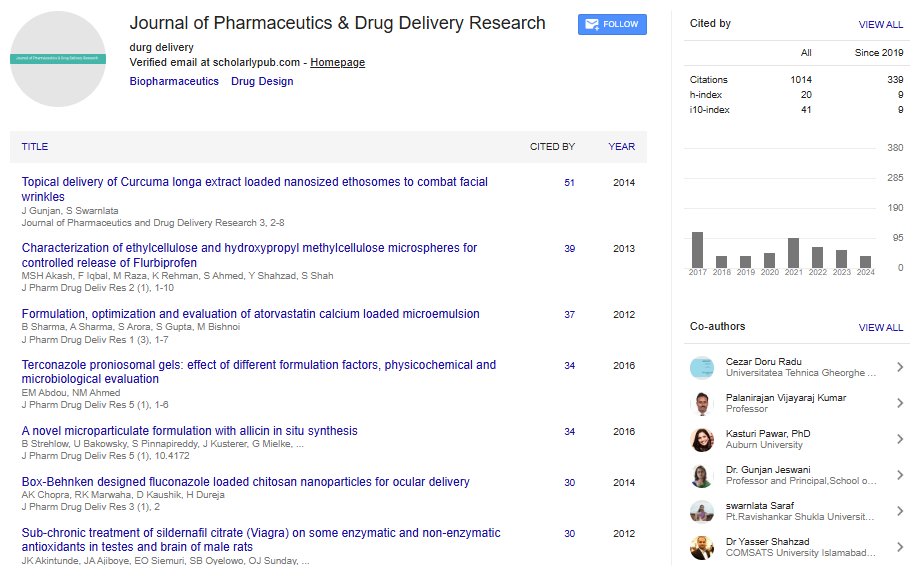Commentary, J Pharm Drug Deliv Res Vol: 13 Issue: 6
Pharmacovigilance: Ensuring Drug Safety and Efficacy
Elisabeth Claire*
1Department of Clinical Pharmacology, Nantes University Hospital, Nantes, France
*Corresponding Author: Elisabeth Claire,
Department of Clinical Pharmacology,
Nantes University Hospital, Nantes, France
E-mail: clai.elisa@gmail.com
Received date: 28 October, 2024, Manuscript No. JPDDR-24-154170;
Editor assigned date: 30 October, 2024, PreQC No. JPDDR-24-154170 (PQ);
Reviewed date: 13 November, 2024, QC No. JPDDR-24-154170;
Revised date: 20 November, 2024, Manuscript No. JPDDR-24-154170 (R);
Published date: 29 November, 2024, DOI: 10.4172/2325-9604.1000313
Citation: Claire E (2024) Pharmacovigilance: Ensuring Drug Safety and Efficacy. J Pharm Drug Deliv Res 13:6.
Description
Pharmacovigilance is the science and practice of identifying, analyzing, cognition and preventing adverse effects or other difficulties associated with drugs. It is an essential component of public health that ensures the safety and efficacy of pharmaceutical products throughout their lifecycle. As new drugs are developed and approved, the importance of pharmacovigilance continues to grow, addressing the complexities of modern medicine and global healthcare systems.
Objectives of pharmacovigilance
The primary objectives of pharmacovigilance include:
Identifying Adverse Drug Reactions (ADRs): Detecting severe side effects associated with pharmaceutical products.
Improving patient safety: Ensuring that drugs are used effectively and safely in real-world settings.
Enhancing risk-benefit profiles: Continuously evaluating whether the benefits of medications higher than its risk factors.
Enabling rational drug use: Educating healthcare professionals and patients about the safe use of medications.
Regulatory compliance: Considering the requirements of national and international regulatory organizations.
Major components of pharmacovigilance
The essential elements of pharmacovigilance include. Adverse Drug Reaction (ADR) is random and harmful effects caused by a drug under normal usage. They are classified into two categories: Type A (augmented) predictable and dose-dependent reactions, such as toxicity or side effects. Type B (bizarre) associated to the drug's pharmacological action, frequently involving hypersensitivity. Effective ADR monitoring involves reporting systems for healthcare professionals and patients.
Signal detection involves identifying new ADRs from large datasets. Advanced statistical and computational tools are used to analyze developments and identify patterns that require further investigation. Risk Management Plans (RMPs) are developed during a drug’s approval process to reduce potential risks. These plans outline: Measures to minimize ADRs. Post-market studies to monitor long-term safety. Pharmaceutical companies are required to submit Periodic Safety Update Reports (PSURs) to regulatory agencies. These reports provide a comprehensive overview of a drug’s safety profile, including new data on ADRs, clinical trials and patient outcomes. After a medicine has been authorized, pharmacovigilance continues through independent reporting mechanisms, observational studies and Real- World Evidence (RWE) from electronic health records and registries.
Role of technology in pharmacovigilance
Technological advancements are transforming pharmacovigilance: Enables real-time monitoring of ADRs from multiple sources. Enhances the traceability and transparency of drug supply chains. Increase reports of adverse reactions for patients and healthcare professionals. Provide continuous monitoring of patient health, capturing potential ADRs in real-time.
Future of pharmacovigilance
As the pharmaceutical environment develops, pharmacovigilance must adapt to address new challenges. Future trends include: Personalized pharmacovigilance personalizing drug safety monitoring to individual genetic profiles and patient populations. Strengthening international partnerships to share data and harmonize practices. Using Artificial Intelligence (AI) to identify and prevent adverse drug reactions with novel accuracy. Empowering patients to actively participate in drug safety monitoring.
Pharmacovigilance in public health
Pharmacovigilance is essential for: Detecting safety signals during public health emergencies, such as vaccine-related ADRs during the COVID-19 pandemic. Monitoring the safety of medications used in mass treatment programs for neglected tropical diseases. Addressing the increasing impact of antibiotic resistance by ensuring the appropriate use of antibiotics.
Challenges in pharmacovigilance
An enormous amount of data generated from diverse sources can be difficult. Efficient data management systems are essential to extract useful knowledge. Differences in regulatory requirements, healthcare systems and monitoring communities across countries provide challenges to standardizing pharmacovigilance practices. Biologics, gene therapies and personalized medicine present unique challenges due to their complexity and novel mechanisms of action.
 Spanish
Spanish  Chinese
Chinese  Russian
Russian  German
German  French
French  Japanese
Japanese  Portuguese
Portuguese  Hindi
Hindi 
